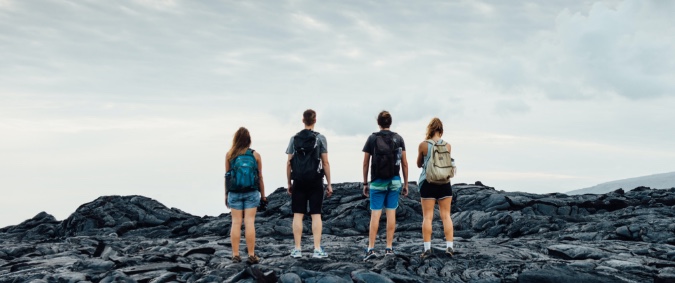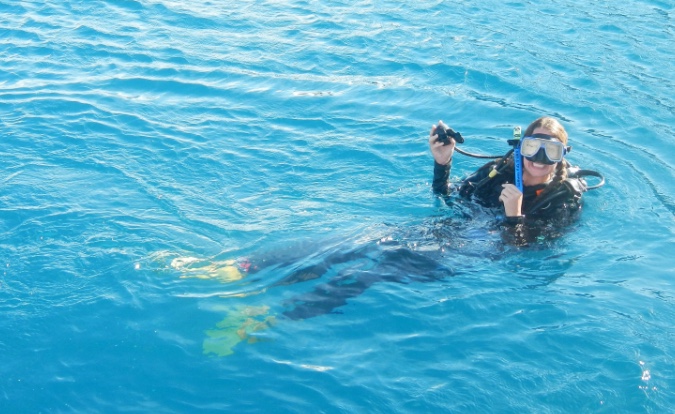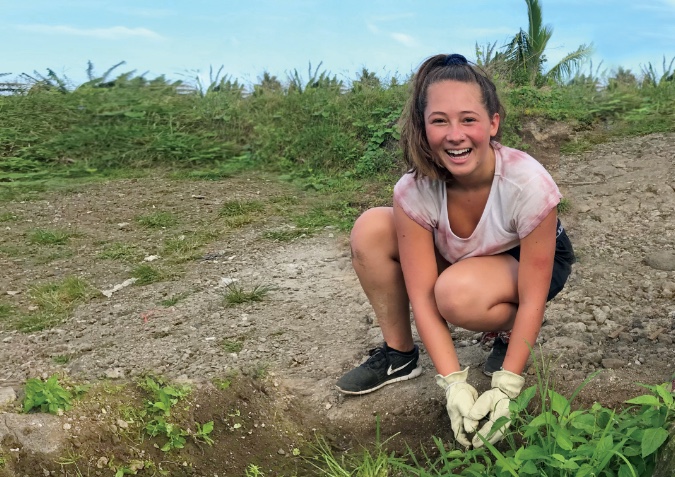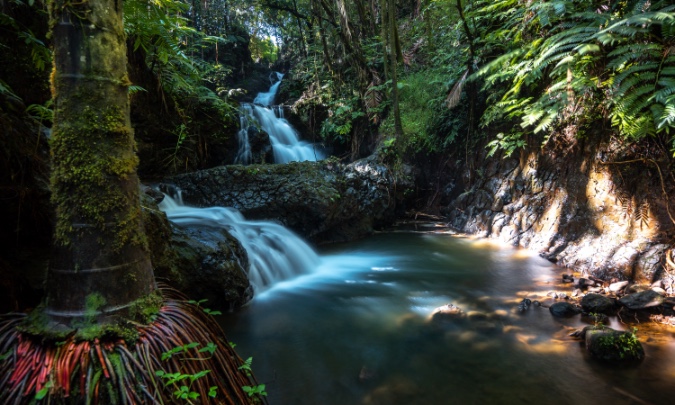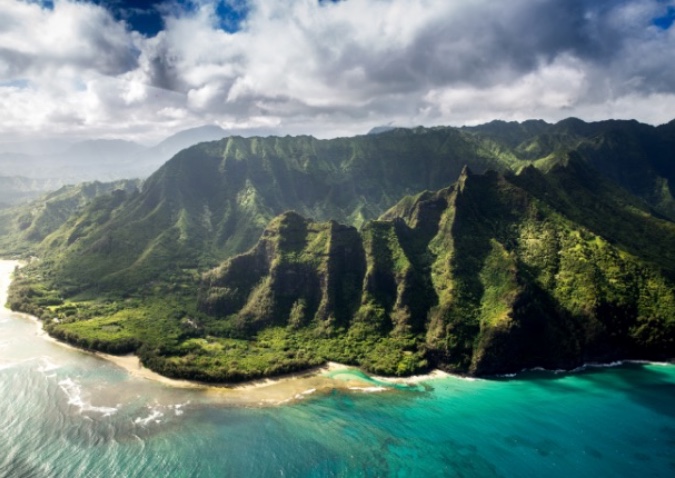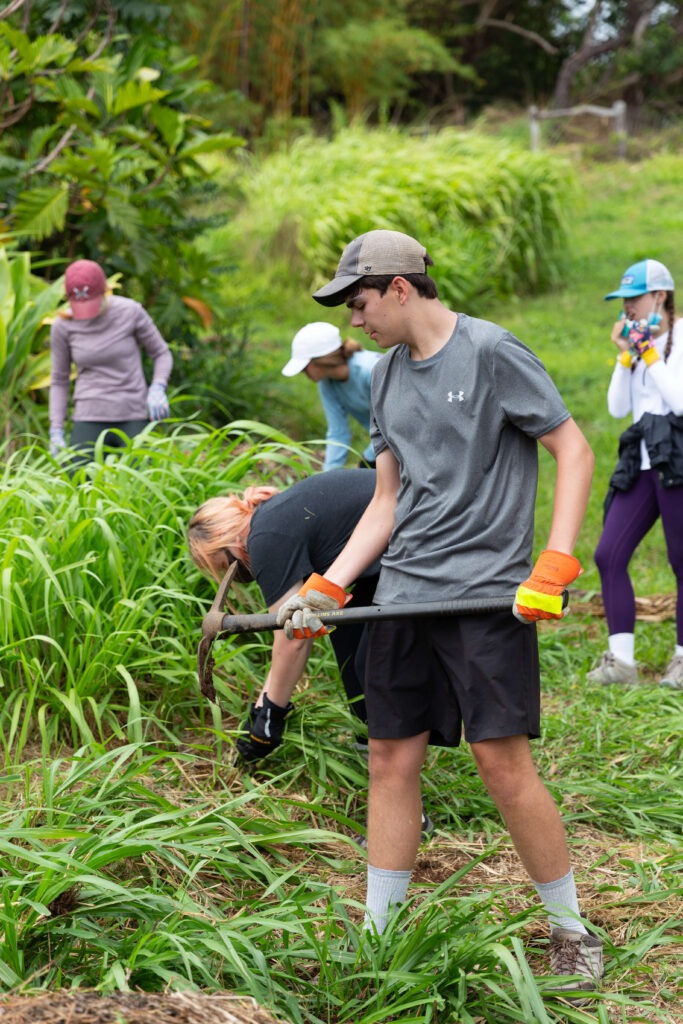Hawai’i
Island Habitat Restoration & Hawaiian Culture
Experience Hawaii’s incredible biodiversity, stunning beaches, and rich cultural heritage as you explore the Big Island and Maui. These volcanic islands are home to an incredibly unique biology and culture, both of which are threatened by outside forces ranging from tourism to climate change. This summer, collaborate with local organizations and community members on environmental conservation and cultural revitalization. Learn about the Hawaiian concept of Malama ‘Āina, or caring for the land, as you work in partnership with local non-profit organizations to plant and harvest staple crops such as taro, remove invasive species, and work on various land rehabilitation and cultural revitalization projects on the north side of the Big Island and in the Olowalu Valley on Maui. Meet and “talk story” with islanders working diligently to preserve Hawaiian history and culture, snorkel with manta rays off the Kona coast, stargaze atop Mauna Kea, and take surf lessons on Maui.
- Highlights
• Collaborate with Hawaiian elders and nonprofits to restore the natural environment
• Learn to surf in Maui’s pristine waters and snorkel in wildlife-rich bays
• Take part in engaging, hands-on cultural workshops and interactive classes
Itinerary
This itinerary represents our best projection of the group’s schedule. However, we may implement changes designed to improve the quality of the program.
Meet your fellow high school student travelers and one or more of your leaders in Los Angeles, and fly together to Kona, Hawai'i. To learn more about how we organize travel, click here.
From the airport, head northeast to Waimea, the home of Paniolos, cattle ranches, and rolling grasslands. Get to know your group and participate in an in-depth orientation on your time in Hawai'i. Partner with Ulu Mau Puanui, an organization dedicated to understanding and preserving ancient Hawaiian agricultural practices, and educating students about sustainability. Help plant and harvest native crops, clear invasive species, and learn about Hawaii’s many ecosystems and climate zones. Hike to a nearby cinder cone to catch a glimpse of the expansive Kohala Field System and learn about how our partners are working hard to revitalize and conserve this land for future generations. In the afternoons after your service work, head to the beach for a swim or venture out for a hike in the forest near your accommodations.
Head to the pristine, calm waters of the western coast to cap off your time on the Big Island. Unwind with your group as you explore the town’s many beaches, shops, and cafes. Spend your last evening here on a magical evening snorkel in an area where manta rays, the ocean’s gentle giants, come to feed.
Fly to Maui for your final days of the program, where you will work alongside a local organization dedicated to the stewardship and preservation of the sacred Olowalu Valley, which was once a place of refuge for those seeking sanctuary. Continue learning about and practicing Malama 'Āina as you tend to the land alongside local facilitators through planting, harvesting, removing invasives, and more. End your trip with a traditional ‘awa ceremony led by a community elder where you will reflect on what you have learned and the important work you’ve done to help preserve these fragile ecosystems.
Fly from Maui to Los Angeles with your group and a leader, then continue on to your final destination. To learn more about how we organize travel, click here.
Itinerary
This itinerary represents our best projection of the group’s schedule. However, we may implement changes designed to improve the quality of the program.
Meet your fellow high school student travelers and one or more of your leaders in Los Angeles, and fly together to Kona, Hawai'i. To learn more about how we organize travel, click here.
From the airport, head northeast to Waimea, the home of Paniolos, cattle ranches, and rolling grasslands. Get to know your group and participate in an in-depth orientation on your time in Hawai'i. Partner with Ulu Mau Puanui, an organization dedicated to understanding and preserving ancient Hawaiian agricultural practices, and educating students about sustainability. Help plant and harvest native crops, clear invasive species, and learn about Hawaii’s many ecosystems and climate zones. Hike to a nearby cinder cone to catch a glimpse of the expansive Kohala Field System and learn about how our partners are working hard to revitalize and conserve this land for future generations. In the afternoons after your service work, head to the beach for a swim or venture out for a hike in the forest near your accommodations.
Head to the pristine, calm waters of the western coast to cap off your time on the Big Island. Unwind with your group as you explore the town’s many beaches, shops, and cafes. Spend your last evening here on a magical evening snorkel in an area where manta rays, the ocean’s gentle giants, come to feed.
Fly to Maui for your final days of the program, where you will work alongside a local organization dedicated to the stewardship and preservation of the sacred Olowalu Valley, which was once a place of refuge for those seeking sanctuary. Continue learning about and practicing Malama 'Āina as you tend to the land alongside local facilitators through planting, harvesting, removing invasives, and more. End your trip with a traditional ‘awa ceremony led by a community elder where you will reflect on what you have learned and the important work you’ve done to help preserve these fragile ecosystems.
Fly from Maui to Los Angeles with your group and a leader, then continue on to your final destination. To learn more about how we organize travel, click here.
Leaders
Meet some of our featured leaders. Please note that these may not be your leaders for the program.
Leaders
Meet some of our featured leaders. Please note that these may not be your leaders for the program.
Hawai'i is the birthplace of surfing, hula, and the ukulele, among countless other contributions to global culture. The most remote island chain on Earth, these islands were first settled by Polynesian explorers 1,500 years ago; since then, many waves of immigration have followed. The islands were annexed by the U.S. in 1898, against the will of Native Hawaiians, who proudly maintain their cultural traditions and language to this day. From coral reefs and fresh lava flows, to snow capped volcanic peaks, the landscape offers incredible variety and endless opportunities for exploration.
English is the official language of Hawai'i, though most of our service partners and contacts are Native Hawaiian and proudly speak Hawaiian. You will have an opportunity to learn phrases and practice the Hawaiian language throughout the program.
Hawai'i is home to the majority of the climatic zones found on Earth, from tropical rainforests to alpine tundra. Expect temperatures ranging from approximately 85°F (30°C) to 65°F (18°C). At high elevations, the temperature can dip to as low as 50°F (10°C). Prepare for some windy days on the south side of the island, and some wet days on the east coast.
Hawaiian food contains a fusion of native crops and cooking techniques brought by the earliest Polynesian settlers, as well as Portuguese, American, Chinese, Japanese, and Korean immigrants. Expect to try local staples like taro and passionfruit alongside modern dishes like poke and spam musubi.
Hawai'i is the birthplace of surfing, hula, and the ukulele, among countless other contributions to global culture. The most remote island chain on Earth, these islands were first settled by Polynesian explorers 1,500 years ago; since then, many waves of immigration have followed. The islands were annexed by the U.S. in 1898, against the will of Native Hawaiians, who proudly maintain their cultural traditions and language to this day. From coral reefs and fresh lava flows, to snow capped volcanic peaks, the landscape offers incredible variety and endless opportunities for exploration.
English is the official language of Hawai'i, though most of our service partners and contacts are Native Hawaiian and proudly speak Hawaiian. You will have an opportunity to learn phrases and practice the Hawaiian language throughout the program.
Hawai'i is home to the majority of the climatic zones found on Earth, from tropical rainforests to alpine tundra. Expect temperatures ranging from approximately 85°F (30°C) to 65°F (18°C). At high elevations, the temperature can dip to as low as 50°F (10°C). Prepare for some windy days on the south side of the island, and some wet days on the east coast.
Hawaiian food contains a fusion of native crops and cooking techniques brought by the earliest Polynesian settlers, as well as Portuguese, American, Chinese, Japanese, and Korean immigrants. Expect to try local staples like taro and passionfruit alongside modern dishes like poke and spam musubi.
What to Expect
Review specific program expectations here. For more general information:
During your time in Hawai'i, you can expect to work on a few different service projects, most of which are focused on conservation and restoration of the land and native plant species. The focus of this program is learning about another culture and ecosystem by forming meaningful relationships with local people and undertaking shared service experiences together. You should come to this summer program with an open mind, eager to participate in new experiences and interested in exploring another culture and way of life. Everyone participates in all of the group’s projects. To learn more about our Service programs click here.
Pursue an independent project and explore an aspect of local culture of particular interest to you—Hawai'i’s history, geology, or conservation efforts, for example. You will have designated project time to create a final project to share your learning with your peers. Formats can range from a formal presentation to an interactive workshop to a photography portfolio, and your group leaders can help you develop a topic and carry out the project.
To encourage full engagement and immersion in the Putney travel experience, we limit the use of cell phones and other devices on our High School programs. Students are allowed to use their phones in transit to the program, and keep their devices throughout. During in-country orientation, leaders will lock phones with a code, unlocking them for the second half of the program. During the tech-free portion of the program, students have the opportunity for a weekly call home according to a pre-arranged schedule. For more details, please see our FAQ.
This is a physically active summer travel program. The group will go on long hikes and engage in moderately strenuous service activities in the elements. You do not need to be at peak fitness to participate, but it is important that you have a desire to be physically active, and that you are excited about trying all activities.
Depending on weather conditions, this program may visit one or two high-altitude destinations—Mauna Kea, on the Big Island, which reaches an elevation of 9,200 feet/2,804 meters, and Haleakalā on Maui, which reaches an elevation of 9,740 feet/2,969 meters.
In Waimea, we stay in a large, shared house on Hawaii Preparatory Academy’s Campus. In Kona we stay in a locally owned hostel with comfortable, dormitory style rooms of 4-8 beds. Sleeping areas and bathrooms are divided by gender. On Maui, we stay in round canvas “tentalows.” Leaders reside with students throughout the program.
On many days, we make and pack our own lunches, particularly when doing service at remote locations. We also enjoy many meals in Waimea at the HPA campus cafeteria, which provides both local Hawaiian and western options. At other stops on our itinerary, we enjoy most meals from local Hawaiian establishments, so the group has a chance to taste the incredible fusion flavors of the islands.
What to Expect
Review specific program expectations here. For more general information:
During your time in Hawai'i, you can expect to work on a few different service projects, most of which are focused on conservation and restoration of the land and native plant species. The focus of this program is learning about another culture and ecosystem by forming meaningful relationships with local people and undertaking shared service experiences together. You should come to this summer program with an open mind, eager to participate in new experiences and interested in exploring another culture and way of life. Everyone participates in all of the group’s projects. To learn more about our Service programs click here.
Pursue an independent project and explore an aspect of local culture of particular interest to you—Hawai'i’s history, geology, or conservation efforts, for example. You will have designated project time to create a final project to share your learning with your peers. Formats can range from a formal presentation to an interactive workshop to a photography portfolio, and your group leaders can help you develop a topic and carry out the project.
To encourage full engagement and immersion in the Putney travel experience, we limit the use of cell phones and other devices on our High School programs. Students are allowed to use their phones in transit to the program, and keep their devices throughout. During in-country orientation, leaders will lock phones with a code, unlocking them for the second half of the program. During the tech-free portion of the program, students have the opportunity for a weekly call home according to a pre-arranged schedule. For more details, please see our FAQ.
This is a physically active summer travel program. The group will go on long hikes and engage in moderately strenuous service activities in the elements. You do not need to be at peak fitness to participate, but it is important that you have a desire to be physically active, and that you are excited about trying all activities.
Depending on weather conditions, this program may visit one or two high-altitude destinations—Mauna Kea, on the Big Island, which reaches an elevation of 9,200 feet/2,804 meters, and Haleakalā on Maui, which reaches an elevation of 9,740 feet/2,969 meters.
In Waimea, we stay in a large, shared house on Hawaii Preparatory Academy’s Campus. In Kona we stay in a locally owned hostel with comfortable, dormitory style rooms of 4-8 beds. Sleeping areas and bathrooms are divided by gender. On Maui, we stay in round canvas “tentalows.” Leaders reside with students throughout the program.
On many days, we make and pack our own lunches, particularly when doing service at remote locations. We also enjoy many meals in Waimea at the HPA campus cafeteria, which provides both local Hawaiian and western options. At other stops on our itinerary, we enjoy most meals from local Hawaiian establishments, so the group has a chance to taste the incredible fusion flavors of the islands.
A Day in the Life: Waimea
- Morning
- Afternoon
- Evening
A Day in the Life:
Waimea
- Morning
- Afternoon
- Evening
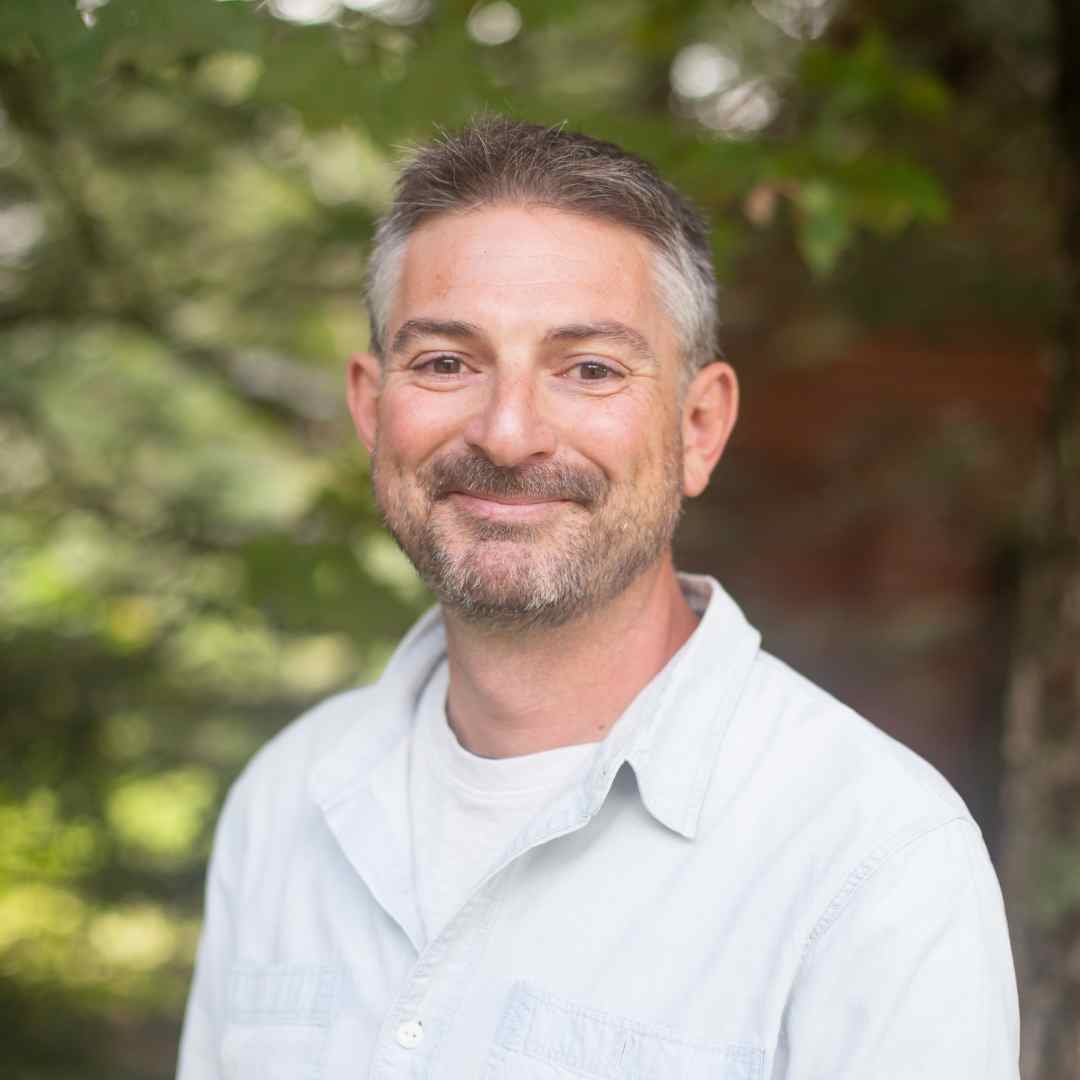
Program Directed by
If you have questions or would like to talk further about this program, please get in touch!




